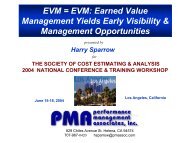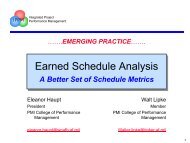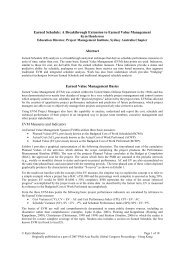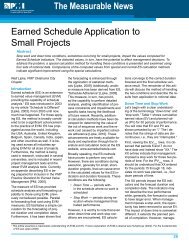Connecting Earned Value to the Schedule (1044) - Micro Planning ...
Connecting Earned Value to the Schedule (1044) - Micro Planning ...
Connecting Earned Value to the Schedule (1044) - Micro Planning ...
You also want an ePaper? Increase the reach of your titles
YUMPU automatically turns print PDFs into web optimized ePapers that Google loves.
<strong>Connecting</strong> <strong>Earned</strong> <strong>Value</strong> <strong>to</strong> <strong>the</strong> <strong>Schedule</strong>Walt LipkeSoftware DivisionTinker AFB, OklahomaAbstract. For project cost, analysts can predict <strong>the</strong> final value with someconfidence using <strong>the</strong> Independent Estimate at Completion (IEAC) formulas from<strong>Earned</strong> <strong>Value</strong> Management (EVM). 1 The formulas provide a means <strong>to</strong> understand<strong>the</strong> financial health of a project without having <strong>to</strong> reassess <strong>the</strong> cost value for eachof <strong>the</strong> unfinished tasks. <strong>Earned</strong> value analysts cannot assess <strong>the</strong> health ofschedule performance in <strong>the</strong> same manner. EVM does not provide IEAC-likeformulas by which <strong>to</strong> predict <strong>the</strong> final duration of a project. Many who areknowledgeable of earned value express <strong>the</strong> opinion that schedule informationderived from EVM is of little value. This paper discusses <strong>the</strong> problem anddevelops a methodology for calculating <strong>the</strong> predicted project duration using EVMdata. The methodology uses <strong>the</strong> concept of <strong>Earned</strong> <strong>Schedule</strong> and introduces anadditional measure required for <strong>the</strong> calculation.Introduction<strong>Earned</strong> <strong>Value</strong> Management (EVM) is a wonderful management methodconnecting in a very unique way, cost, schedule, and technical performance. Itprovides capability which facilitates a more scientific approach <strong>to</strong> projectmanagement; i.e. through <strong>the</strong> use of EVM, project status is now described fromnumerical evidence. Although this advancement in management method istremendously significant, EVM has three major deficiencies:1) The performance indica<strong>to</strong>rs are not directly connected <strong>to</strong> projec<strong>to</strong>utput. For example, miles<strong>to</strong>ne completion or delivery of productsmay not meet <strong>the</strong> cus<strong>to</strong>mer’s expectation, yet EVM indica<strong>to</strong>r valuesare acceptable.2) The schedule indica<strong>to</strong>rs are flawed. For projects completing late, <strong>the</strong>indica<strong>to</strong>rs always show perfect schedule performance.3) The performance indica<strong>to</strong>rs are not explicitly connected <strong>to</strong>appropriate management action. Even with EVM data, <strong>the</strong> projectmanager remains reliant upon his intuition as <strong>to</strong> any action needed.The first two deficiencies cited are reasons as <strong>to</strong> why EVM is generallyregarded as a cost management <strong>to</strong>ol; <strong>the</strong> information relating <strong>to</strong> scheduleperformance is inadequate. In fact, <strong>the</strong>re are many knowledgeable users whoexpress <strong>the</strong> opinion that <strong>the</strong> prediction of project duration from <strong>the</strong> use of <strong>the</strong>schedule indica<strong>to</strong>rs is an exercise in futility.1© Walt Lipke
Although <strong>the</strong>re are barriers <strong>to</strong> having an estimating formula for predictingfinal project duration from EVM data, it remains a desired capability. Projectmanagers (PM) need <strong>the</strong> ability <strong>to</strong> generate reasonable estimates of <strong>the</strong> duration.Fur<strong>the</strong>rmore, <strong>the</strong>y need <strong>to</strong> be able <strong>to</strong> estimate a revised completion date at everyreporting period without having <strong>to</strong> exhaustingly evaluate <strong>the</strong> tasks remaining eachtime. That is, <strong>to</strong> manage cost and schedule equally well, PMs need comparableanalysis capability for both.For <strong>the</strong> remainder of <strong>the</strong> paper, I’ll discuss what is known about projectperformance. I’ll <strong>the</strong>n describe <strong>the</strong> mechanisms which may cause <strong>the</strong> behavior.From this foundation, a new performance measure is proposed. The new measureprovides <strong>the</strong> connection of project output <strong>to</strong> EVM indica<strong>to</strong>rs and facilitates <strong>the</strong>estimation of final project duration.Behavior of <strong>the</strong> Cost Performance IndexDuring <strong>the</strong> 1990s and through 2002, a considerable amount of research wasperformed concerning <strong>the</strong> independent estimate at completion (IEAC) formulasand <strong>the</strong> cost performance index (CPI) from <strong>Earned</strong> <strong>Value</strong> Management [2,3,4,5,6].The research, inspired by <strong>the</strong> cancellation of <strong>the</strong> Navy’s A-12 Avenger acquisitionprogram, focused, primarily, on <strong>the</strong> accuracy of <strong>the</strong> various formulas for IEAC.However, some of <strong>the</strong> studies examined <strong>the</strong> behavior of CPI over <strong>the</strong> life of <strong>the</strong>project.The findings from <strong>the</strong> IEAC studies were mostly generalizations. Possibly,<strong>the</strong> most significant result is that <strong>the</strong> equations using <strong>the</strong> schedule performanceindex (SPI) in <strong>the</strong> performance fac<strong>to</strong>r (PF) are better applied early in <strong>the</strong> project.In my opinion, <strong>the</strong> studies of CPI are extremely significant <strong>to</strong> projectmanagement. Important observations were made as <strong>to</strong> how <strong>the</strong> cost index behavesfrom <strong>the</strong> project’s beginning until its completion. This behavior explains <strong>the</strong>findings from <strong>the</strong> IEAC studies, and validates <strong>the</strong> use of IEAC = BAC / CPI <strong>to</strong>predict final cost (BAC is <strong>the</strong> project Budget at Completion). The CPI studyfindings are <strong>the</strong> following:1) The result from IEAC = BAC / CPI is a reasonable running estimateof <strong>the</strong> low value for final cost.2) The cumulative value of CPI stabilizes by <strong>the</strong> time <strong>the</strong> project is 20percent complete. Stability is defined <strong>to</strong> mean that <strong>the</strong> final CPI doesnot vary by more than 0.10 from <strong>the</strong> value at 20 percent complete.3) The value of CPI tends only <strong>to</strong> worsen from <strong>the</strong> point of stability untilproject completion.These results have come from applying methodical statistical testing <strong>to</strong> asmany as 200 large Department of Defense projects. Finding number 2 isestablished at <strong>the</strong> statistical confidence level of 95 percent. Thus, in <strong>the</strong> very earlystage of a project, approximately 20 percent complete, <strong>the</strong> project manager has agood estimate of <strong>the</strong> high and low bounds of final cost. As <strong>the</strong> project progresses,<strong>the</strong> low bound is refined by using <strong>the</strong> knowledge from finding number 1. Finally,2© Walt Lipke
finding 3 indicates that risk impacts tend <strong>to</strong> occur late in <strong>the</strong> project; it reminds us<strong>to</strong> moni<strong>to</strong>r and manage <strong>the</strong> risks <strong>to</strong> minimize <strong>the</strong> worsening of cost efficiency as<strong>the</strong> project progresses. These are extremely useful PM <strong>to</strong>ols.What Causes CPI <strong>to</strong> Worsen?In struggling <strong>to</strong> answer this question, I began <strong>to</strong> think about what happensin <strong>the</strong> execution of <strong>the</strong> planned project tasks. Early in <strong>the</strong> project <strong>the</strong>re are manytasks available <strong>to</strong> work, but as <strong>the</strong> project moves <strong>to</strong>ward completion <strong>the</strong> numbergrows smaller. If impediments occur early, <strong>the</strong> PM may not take notice because aworker was shifted from <strong>the</strong> stalled task <strong>to</strong> ano<strong>the</strong>r for which he could gain EV. On<strong>the</strong> o<strong>the</strong>r hand, when impediments occur late, <strong>the</strong>re may not be o<strong>the</strong>r EV <strong>to</strong> work.If that is <strong>the</strong> case, cost efficiency suffers ...and so would schedule performance.And certainly, <strong>the</strong> PM will become very aware of <strong>the</strong> impediment and what effectsit is having upon his project’s performance.This deduction, seemingly, is reasonable and <strong>the</strong> rationale qualitativelyexplains why <strong>the</strong> studies observed CPI worsening as EV increased. But, <strong>the</strong>n Iwondered, “Do <strong>the</strong> early impediments cause late impacts, as well?” At first, itwasn’t obvious that <strong>the</strong>y might, but I soon realized performing work out ofsequence is a likely cause of rework.When impediments occur early and workers are redirected <strong>to</strong> perform tasksout of sequence with <strong>the</strong> plan, I reasoned <strong>the</strong>y must do so at risk. It is a riskbecause <strong>the</strong> tasks performed not in accordance with <strong>the</strong> plan do not have all of <strong>the</strong>inputs necessary. When inputs aren’t fully defined, significant task rework can beexpected; <strong>the</strong> workers are having <strong>to</strong> fill-in <strong>the</strong> missing inputs using <strong>the</strong>ir ownintuition and technical knowledge. When <strong>the</strong>y anticipate well, all is fine; but if not,<strong>the</strong> task can expect rework, possibly, of <strong>the</strong> order of 50 percent, or even greater.The rework for <strong>the</strong> task will appear later in <strong>the</strong> project and is likely <strong>to</strong> ripple in<strong>to</strong>subsequent tasks, as it is discovered that functions don’t perform as expected.In general, processes have limitations; i.e., <strong>the</strong>re are bottlenecks orconstraints which, when overloaded, limit task progress. The aggregation ofrework can overcome <strong>the</strong> work flow planned in <strong>the</strong> project schedule and causeoverloading of <strong>the</strong> process constraint. The PM, <strong>to</strong> keep work flowing when alimiting constraint is encountered, may knowingly shift workers <strong>to</strong> alternativetasks. By taking this proactive approach, <strong>the</strong> PM inadvertently creates morerework. At this point it is apparent, rework cascades and causes performanceefficiency <strong>to</strong> suffer, increasingly.Possibly, <strong>the</strong>se thoughts explain <strong>the</strong> reason for <strong>the</strong> exorbitant reworkassociated with software development projects. Software development rework isreported <strong>to</strong> be approximately 40 percent [ 7]. Consistent with <strong>the</strong> precedingdiscussion this statistic would indicate <strong>the</strong> developers on <strong>the</strong> project teamfrequently vary from <strong>the</strong> development plan. Or, even worse, it may indicate <strong>the</strong>re islittle requirements definition in software development projects and likely, onlyvery cursory project planning and task definition. We know from <strong>the</strong> March 2004report prepared by <strong>the</strong> United States General Accounting Office, StrongerManagement Practices Are Needed <strong>to</strong> Improve DOD’s Software Intensive3© Walt Lipke
ES indica<strong>to</strong>rs are time-based. The ES indica<strong>to</strong>rs are derived from <strong>the</strong> timeassociation with earned value and <strong>the</strong> performance management baseline (PMB)as depicted by Figure 1, <strong>Earned</strong> <strong>Schedule</strong> Concept. 3 The application of ES is <strong>the</strong>facilita<strong>to</strong>r for creating <strong>the</strong> bridge between cost and schedule management.EVSPI($) =PVSV($) = EV − PVPVESSPI(t) =ATSV(t) = ES − ATProjection of EVon<strong>to</strong> PV$$EVES = Jan thru May + Portion of JuneEV($) - PV(May)ES = 5 +PV(June) - PV(May)AT = 7J F M A M J J A S O NTimeFigure 1. <strong>Earned</strong> <strong>Schedule</strong> ConceptThe computed value of ES describes where <strong>the</strong> project should be in itsschedule performance. Refer <strong>to</strong> Figure 2, <strong>Earned</strong> <strong>Schedule</strong> - Bridges EVM <strong>to</strong><strong>Schedule</strong> (Plan). The figure shows a networked schedule at <strong>the</strong> <strong>to</strong>p and <strong>the</strong> projectmanagement baseline beneath it. The project status is taken at AT, actual time;however, <strong>the</strong> time performance of <strong>the</strong> project management baseline is depicted, asshown in figure 1, by ES.<strong>Earned</strong> <strong>Schedule</strong> provides a remarkable connection between EVM and <strong>the</strong>schedule. Regardless of <strong>the</strong> project’s actual position in time, we have informationdescribing <strong>the</strong> portion of <strong>the</strong> planned schedule which should have beenaccomplished. Specific tasks make up that portion of <strong>the</strong> schedule. If <strong>the</strong> scheduleis adhered <strong>to</strong> we will observe in <strong>the</strong> actual performance <strong>the</strong> identical tasks at <strong>the</strong>same level of completion as <strong>the</strong> tasks which make up <strong>the</strong> plan portion attributed <strong>to</strong>ES. (The darker shaded areas of <strong>the</strong> task blocks indicate <strong>the</strong> completed portions.)5© Walt Lipke
$$PVBACEVSV(t)ES AT PDTimeFigure 2. <strong>Earned</strong> <strong>Schedule</strong> - Bridges EVM <strong>to</strong> <strong>Schedule</strong> (Plan)However, it is more than likely <strong>the</strong> project is performing as depicted inFigure 3, <strong>Earned</strong> <strong>Schedule</strong> – Bridges EVM <strong>to</strong> <strong>Schedule</strong> (Actual); i.e., EV is notbeing accrued in accordance with <strong>the</strong> plan. As seen, <strong>the</strong> earned value is <strong>the</strong> same asdepicted in figure 2, but <strong>the</strong> task distribution is different. Figure 3 is a graphicalillustration of <strong>the</strong> previous discussion, “What Causes CPI <strong>to</strong> Worsen?” The laggingperformance for tasks <strong>to</strong> <strong>the</strong> left of ES indicates <strong>the</strong> possibility of a constraint orimpediment. The EV indicated <strong>to</strong> <strong>the</strong> right of ES shows tasks performed at risk;<strong>the</strong>y will likely have significant rework appearing later in <strong>the</strong> project.Both sets of tasks, lagging and ahead, cause poor efficiency. Of course, for<strong>the</strong> lagging tasks, impediments and constraints make progress more difficult.Concentrating management efforts on alleviating <strong>the</strong> impediments will have <strong>the</strong>greatest positive impact on project performance. The tasks <strong>to</strong> <strong>the</strong> right of ES areperformed without complete information. The performers of <strong>the</strong>se tasksnecessarily create <strong>the</strong> inputs expected from <strong>the</strong> incomplete preceding tasks; thisconsumes time and effort and has no associated earned value.This discussion leads <strong>to</strong> measuring schedule adherence. By determining <strong>the</strong>earned value (EV) for <strong>the</strong> actual tasks performed congruent with <strong>the</strong> projectschedule, a measure can be created. The adherence <strong>to</strong> schedule characteristic, P, isdescribed ma<strong>the</strong>matically as a ratio:whereP = Σ EVj / Σ PVjPVj is <strong>the</strong> planned value for tasks associated with ESEVj is <strong>the</strong> earned value at AT (actual time) corresponding <strong>to</strong> andlimited by <strong>the</strong> planned tasks, PVj6© Walt Lipke
One observation of <strong>the</strong> P-Fac<strong>to</strong>r is that its value must be between zero and one; itcannot exceed one. A second characteristic is that at project completion it willexactly equal 1.0.BAC$$EVPVSV(t)ES AT PDTimeFigure 3. <strong>Earned</strong> <strong>Schedule</strong> - Bridges EVM <strong>to</strong> <strong>Schedule</strong> (Actual)Making Use of <strong>the</strong> P- Fac<strong>to</strong>rWhen <strong>the</strong> value for P is much less than 1.0, <strong>the</strong> project manager (PM) has astrong indication <strong>the</strong> project is experiencing an impediment, <strong>the</strong> overload of aconstraint, or <strong>the</strong> workforce has poor process discipline. The PM thus has anindica<strong>to</strong>r which enhances <strong>the</strong> description portrayed by EVM.To understand how P can be used beyond its qualitative application, let’sbegin by identifying some fundamental relationships: Cumulative EV @ AT = EV =Σ EVi @ AT = Σ PVj @ ESwhere ΣEVi includes all of <strong>the</strong> tasks completed or in work EV earned in accordance with <strong>the</strong> schedule: EV(p)= ΣEVj @ AT = P ∗EVwhere <strong>the</strong> subscript j identifies <strong>the</strong> planned tasks associated with ES EV earned not according <strong>to</strong> <strong>the</strong> schedule: EV(r) = EV – EV(p) = (1 – P)∗ EVThe preceding definitions are extremely important <strong>to</strong> <strong>the</strong> remainder of <strong>the</strong>paper. As fur<strong>the</strong>r explanation, <strong>the</strong> tasks planned <strong>to</strong> be completed or in work (i.e.those tasks in agreement with <strong>the</strong> schedule) are left of <strong>the</strong> ES line. The positioningof <strong>the</strong> ES line represents <strong>the</strong> earned duration of <strong>the</strong> project management baseline.This calculated value of ES thus identifies tasks completed and amount of in-work7© Walt Lipke
accomplishment in accordance with <strong>the</strong> schedule. The identified set of plannedtasks, in turn, identifies which of <strong>the</strong> performed tasks are used for calculatingEV(p); i.e., <strong>the</strong> EVj for <strong>the</strong> tasks in consonance with <strong>the</strong> schedule. The EVj for <strong>the</strong>performed tasks is limited <strong>to</strong> <strong>the</strong> PVj at <strong>the</strong> duration equal <strong>to</strong> ES. It may be worthrepeating at this point that <strong>the</strong> actual tasks lagging <strong>the</strong> planned performance at ESlikely have constraints or impediments and those where actual exceeds <strong>the</strong> plancan expect future rework.Now, let’s examine <strong>the</strong> impact of rework. Recall, a portion of EV(r) isunusable and requires rework. Therefore, we need <strong>to</strong> determine <strong>the</strong> usable portionin terms of percentage of rework (R%): R% = unusable fraction of EV(r) / usable fraction of EV(r) = f(r) / f(p)where f(p) + f(r) = 1 Substituting for f(r): f(p) + R% ∗ f(p) = 1 Solving for f(p), we obtain: f(p) = 1 / (1 + R%)Finally, with <strong>the</strong> relationships developed we can calculate <strong>the</strong> EV whicheffectively moves <strong>the</strong> project <strong>to</strong>ward completion: Effective EV = EV(e) = EV(p) + usable portion of EV(r) = EV(p) + f(p)∗ EV(r) EV(e) = EV(p) + [1 / (1 + R%)] ∗ EV(r)= P ∗ EV + [1 / (1 + R%)] ∗ [(1 – P) ∗ EV]= [P + {(1 – P) / (1 + R%)}] ∗ EV EV(e) = [(1 + P ∗ R%) / (1 + R%)] ∗ EVThus, it is determined that <strong>the</strong> plan adherence (P-Fac<strong>to</strong>r), along with rework, andcumulative earned value determine <strong>the</strong> effective earned value.For <strong>the</strong> hypo<strong>the</strong>sis made earlier that for <strong>the</strong> tasks performed out ofsequence rework is 50 percent, <strong>the</strong> equation for <strong>the</strong> effective earned valuebecomes:EV(e) = [(1 + 0.5 ∗ P) / (1 + 0.5)] ∗ EV= [(P + 2) / 3] ∗ EVApplying EV(e)The effective earned value affects <strong>the</strong> values of cost and scheduleperformance efficiency <strong>to</strong> be used for predicting project outcomes. The costperformance index which describes <strong>the</strong> efficiency <strong>to</strong>ward achieving completion of<strong>the</strong> project is:8© Walt Lipke
Project Outcome PredictionTo illustrate <strong>the</strong> application of <strong>the</strong> P - Fac<strong>to</strong>r, I’ll begin by first usingnotional data. Refer <strong>to</strong> Figure 4, Graphs of CPI, CPI(e) & P - Fac<strong>to</strong>r (notional data);observe <strong>the</strong> behavior of CPI. As discussed in <strong>the</strong> section, Behavior of <strong>the</strong> CostPerformance Index, CPI tends <strong>to</strong> worsen as <strong>the</strong> project moves <strong>to</strong>ward completionand <strong>the</strong> final CPI will not be more than 0.10 below its value when <strong>the</strong> project is 20percent complete. Recall, this behavior is well known from several studies[2,3,4,5,6]. The CPI graph depicts <strong>the</strong> final value of CPI <strong>to</strong> be approximately 0.10less than its value at 20 percent complete. Thus, <strong>the</strong> plot shows <strong>the</strong> maximumexpected change for CPI.Now observe <strong>the</strong> behavior of <strong>the</strong> P- Fac<strong>to</strong>r. Its value begins at 0.73 andincreases until it reaches 1.0 at project completion. The P - Fac<strong>to</strong>r has an innatecharacteristic of increasing as <strong>the</strong> project moves <strong>to</strong>ward completion. Thus, <strong>the</strong> useof <strong>the</strong> P- Fac<strong>to</strong>r <strong>to</strong> adjust <strong>the</strong> earned value <strong>to</strong> a lower amount causes <strong>the</strong> effectivevalue of <strong>the</strong> cost performance index, CPI(e), <strong>to</strong> better forecast <strong>the</strong> final CPI value,and hence an improved prediction of final cost.This effect is seen in <strong>the</strong> plot of CPI(e). Of course, <strong>the</strong> perfect compensationindicated is an unreasonable expectation. Never<strong>the</strong>less, <strong>the</strong> concept should beunders<strong>to</strong>od; <strong>the</strong> application of <strong>the</strong> P - Fac<strong>to</strong>r causes CPI(e) <strong>to</strong> be a better forecas<strong>to</strong>f <strong>the</strong> final CPI throughout <strong>the</strong> stable period of performance for <strong>the</strong> project.One final thought before leaving this. From <strong>the</strong> definition of <strong>the</strong> P - Fac<strong>to</strong>r,its value indicates <strong>the</strong> portion of earned value accrued in congruence with <strong>the</strong> plan;i.e., <strong>the</strong> tasks which ought <strong>to</strong> be ei<strong>the</strong>r completed or in work. Thus, for a project <strong>to</strong>drop 0.10 from its CPI value at 20 percent complete, our example tells us thatapproximately 30 percent of <strong>the</strong> project’s task effort is performed not inaccordance with <strong>the</strong> project plan. A project having 30 percent of its effort notfollowing its plan is headed for disaster. Adherence <strong>to</strong> <strong>the</strong> plan must be heeded for<strong>the</strong> project <strong>to</strong> be successful. For this cited condition <strong>the</strong>re may be any of <strong>the</strong>following problems: <strong>the</strong> workers have poor discipline, management is inept, <strong>the</strong>plan itself is poor, or more likely <strong>the</strong>re are impediments or constraints that need <strong>to</strong>be removed. As discussed previously, <strong>the</strong> tasks possibly having constraints orimpediments are identified as those whose earned value lags <strong>the</strong> planned valuecorresponding <strong>to</strong> <strong>the</strong> earned schedule result (reference figure 3).10© Walt Lipke
Index <strong>Value</strong>1.21.11.00.90.8CPI(e)CPIP – Fac<strong>to</strong>r0.70.2 0.3 0.4 0.5 0.6 0.7 0.8 0.9 1.0Percent CompleteFigure 4. Graphs of CPI, CPI(e) & P - Fac<strong>to</strong>r (notional data)Now let’s look at <strong>the</strong> application of <strong>the</strong> P- Fac<strong>to</strong>r using real data from an inworkproject. The data and computed results are portrayed below in Tables 1 and2, Cost Prediction Comparison and <strong>Schedule</strong> Prediction Comparison, respectively,and Figure 5, Graphs of CPI & SPI(t) with <strong>the</strong> P - Fac<strong>to</strong>r. O<strong>the</strong>r data required forunderstanding <strong>the</strong> analysis and discussion are: BAC ($2,488,203), percent reworkassumed for out of sequence tasks (50%), planned duration (PD = 25.7 months).There are two new terms shown in <strong>the</strong> tables, “Period” and “Pct Comp.”Period is <strong>the</strong> number of <strong>the</strong> periodic observation of project status; for this data <strong>the</strong>period is monthly. “Pct Comp” is shorthand for percent complete and is calculatedfrom <strong>the</strong> formula, Pct Comp = EV / BAC. All o<strong>the</strong>r data elements of <strong>the</strong> tables arecommon <strong>to</strong> <strong>the</strong> preceding portions of <strong>the</strong> paper.Reading <strong>the</strong> tables is straight-forward. The values beneath <strong>the</strong> headings oftables 1 and 2 (Period, Pct Comp, AC, EV, and PV) are all data entries from <strong>the</strong>project plan or its performance, while <strong>the</strong> entries for <strong>the</strong> remaining headings arecomputed. For clarification, I’ll discuss <strong>the</strong> first row of numbers for table 1. Atperiod number 7, <strong>the</strong> project is 22.09 percent complete; <strong>the</strong> actual cost accrued is$523,766 and <strong>the</strong> cumulative earned value is $549,707. Corresponding <strong>to</strong> period 7,<strong>the</strong> P-Fac<strong>to</strong>r and IEAC are calculated <strong>to</strong> be 0.92977 and $2,370,790, respectively.Utilizing <strong>the</strong> P-Fac<strong>to</strong>r, <strong>the</strong> effective EV and IEAC are computed. EV(e) is shown <strong>to</strong>be $536,839, while IEAC(e) is $2,427,618.The values shown in <strong>the</strong> IEAC column of table 1 are calculated by dividingBAC by CPI. The values in <strong>the</strong> IEAC(e) column are determined from <strong>the</strong> equationshown earlier:whereIEAC(e) = BAC / CPI(e)CPI(e) = [(2 + P) / 3] ∗ CPI11© Walt Lipke
Likewise, <strong>the</strong> IEAC(t) values in table 2 are determined from <strong>the</strong> equation, IEAC(t)= PD / SPI(t); whereas <strong>the</strong> IEAC(te) values are computed fromIEAC(te) = PD / SPI(te)The effective time-based schedule performance index, SPI(te), is computed usingEV(e) = [(2 + P) / 3] ∗ EVfor determining <strong>the</strong> effective earned schedule, ES(e). As a reminder, <strong>the</strong>se IEACformulas account for <strong>the</strong> 50 percent rework assumption.1.2Index <strong>Value</strong>1.11.00.90.8CPICPI(e)SPI(t)SPI(te)P- Fac<strong>to</strong>r0.70.1 0.2 0.3 0.4 0.5 0.6 0.7 0.8 0.9 1.0Percent CompleteFigure 5. Graphs of CPI & SPI(t) with <strong>the</strong> P - Fac<strong>to</strong>rFrom figure 5 it is seen that <strong>the</strong> value of <strong>the</strong> P - Fac<strong>to</strong>r is extremelyhigh throughout <strong>the</strong> range. Beginning at 30 percent complete its value steadilyincreases from approximately 0.96 <strong>to</strong> nearly 1.0. Thus, an expectation from <strong>the</strong><strong>the</strong>ory is observed: when <strong>the</strong> value of P is high, CPI(e) and SPI(te) will not bemuch different from CPI and SPI(t), respectively. Ano<strong>the</strong>r observation can bemade, this project is performing exceptionally well; <strong>the</strong> cost performance is betterthan planned by, approximately, 5 percent, and <strong>the</strong> schedule performance islagging by only 2 percent. Thus, it can be concluded, when <strong>the</strong> project plan is good,management is engaged, and <strong>the</strong> plan is followed (P – Fac<strong>to</strong>r approaching 1.0), asuccessful project is highly probable.12© Walt Lipke
PeriodPctP-AC EVCompFac<strong>to</strong>rEV(e) IEAC IEAC(e)7 22.09% $ 523,768 $ 549,707 0.92977 $ 536,839 $2,370,790 $2,427,6188 26.88% $ 628,760 $ 668,776 0.91451 $ 649,717 $2,339,324 $2,407,9459 31.53% $ 741,662 $ 784,508 0.96302 $ 774,837 $2,352,310 $2,381,66610 35.42% $ 834,889 $ 881,288 0.96221 $ 870,186 $2,357,199 $2,387,27411 39.65% $ 936,419 $ 986,529 0.93897 $ 966,459 $2,361,817 $2,410,86212 52.24% $1,259,326 $1,299,880 0.95745 $1,281,444 $2,410,575 $2,445,25613 57.15% $1,354,241 $1,422,033 0.97531 $1,410,332 $2,369,583 $2,389,24214 61.36% $1,454,887 $1,526,842 0.97023 $1,511,692 $2,370,943 $2,394,70315 65.03% $1,551,561 $1,617,976 0.97544 $1,604,733 $2,386,068 $2,405,75816 68.97% $1,646,439 $1,716,130 0.98440 $1,707,204 $2,387,159 $2,399,63917 73.43% $1,736,040 $1,826,991 0.99423 $1,823,476 $2,364,336 $2,368,89318 77.59% $1,806,941 $1,930,651 0.99545 $1,927,721 $2,328,767 $2,332,30519 81.02% $1,892,554 $2,015,852 0.99582 $2,013,043 $2,336,014 $2,339,27220 83.95% $1,971,334 $2,088,967 0.99285 $2,083,990 $2,348,089 $2,353,696Table 1. Cost Prediction ComparisonPeriod PV EV ESP-Fac<strong>to</strong>rES(e) IEAC(t) IEAC(te)7 $ 556,918 $ 549,707 6.9415 0.92977 6.8371 25.90 mo 26.26 mo8 $ 671,729 $ 668,776 7.9743 0.91451 7.8083 25.78 mo 26.29 mo9 $ 801,718 $ 784,508 8.8676 0.96302 8.7932 26.06 mo 26.27 mo10 $ 923,464 $ 881,288 9.6536 0.96221 9.5624 26.57 mo 26.81 mo11 $1,029,381 $ 986,529 10.5954 0.93897 10.4059 26.63 mo 27.09 mo12 $1,341,989 $1,299,880 11.8653 0.95745 11.8063 25.98 mo 26.10 mo13 $1,441,133 $1,422,033 12.8074 0.97531 12.6893 26.07 mo 26.30 mo14 $1,533,912 $1,526,842 13.9238 0.97023 13.7605 25.83 mo 26.13 mo15 $1,639,209 $1,617,976 14.7984 0.97544 14.6726 26.04 mo 26.25 mo16 $1,739,801 $1,716,130 15.7647 0.98440 15.6759 26.07 mo 26.21 mo17 $1,835,812 $1,826,991 16.9081 0.99423 16.8715 25.83 mo 25.89 mo18 $1,936,394 $1,930,651 17.9429 0.99545 17.9138 25.78 mo 25.82 mo19 $2,036,976 $2,015,852 18.7900 0.99582 18.7621 25.98 mo 26.02 mo20 $2,137,559 $2,088,967 19.5169 0.99285 19.4674 26.33 mo 26.38 moTable 2. <strong>Schedule</strong> Prediction ComparisonAno<strong>the</strong>r predicted result is also seen from tables 1 and 2. The valuescomputed for IEAC(e) and IEAC(te) are consistently greater than <strong>the</strong>corresponding values for IEAC and IEAC(t), respectively. Recall from <strong>the</strong> IEACand CPI studies cited that <strong>the</strong> result from IEAC = BAC / CPI is a reasonablerunning estimate of <strong>the</strong> low value for final cost. Logically, it must follow that <strong>the</strong>more pessimistic estimate of final cost, IEAC(e), should be a closer estimate of <strong>the</strong>final cost.13© Walt Lipke
The schedule duration estimate from <strong>the</strong> equation IEAC(t) = PD / SPI(t) hasyet <strong>to</strong> be studied sufficiently as <strong>to</strong> its predictive validity. At this time however, wedo know that it is a better predic<strong>to</strong>r than any o<strong>the</strong>r method now employed. Theo<strong>the</strong>r prediction methods have calculationswith ma<strong>the</strong>matical flaws which prevent <strong>the</strong>ir proper functioning [10].Readily observed from table 2 is <strong>the</strong> consistency of <strong>the</strong> predicted values forboth IEAC(t) and IEAC(te). Also, just as for <strong>the</strong> cost prediction values listed intable 1, <strong>the</strong> schedule duration IEAC(te) is always longer than <strong>the</strong> correspondingIEAC(t). Until more study is completed, it remains conjecture that IEAC(te) iscloser <strong>to</strong> <strong>the</strong> final project duration than is IEAC(t).SummaryThe premise put forth by this paper is that <strong>Earned</strong> <strong>Value</strong> Management(EVM) is connected <strong>to</strong> <strong>the</strong> schedule through <strong>the</strong> use of <strong>the</strong> <strong>Earned</strong> <strong>Schedule</strong> (ES)concept. The computed value of ES is used <strong>to</strong> identify <strong>the</strong> tasks of <strong>the</strong> plan thatshould be completed or in-work. Fur<strong>the</strong>rmore, <strong>the</strong> ES value identifies <strong>the</strong> portioncompleted for <strong>the</strong> in-work tasks. This attribute of ES is independent of scheduleperformance efficiency.By comparing <strong>the</strong> actual task distribution of <strong>the</strong> earned value <strong>to</strong> <strong>the</strong> plannedexecution, differences can be observed. For those tasks where earned value (EV)lags <strong>the</strong> expectation, impediments or constraints are <strong>the</strong> likely cause. This ability<strong>to</strong> segregate and identify impeded tasks should prove <strong>to</strong> be very useful <strong>to</strong> projectmanagers. For tasks where EV exceeds expectation, <strong>the</strong> work is being performedwithout all of <strong>the</strong> task inputs satisfied; thus, rework can be expected at some futuretime. Both situations, task performance ahead and lagging with respect <strong>to</strong> <strong>the</strong> plan,cause costs <strong>to</strong> escalate and schedules <strong>to</strong> leng<strong>the</strong>n.A measure is introduced <strong>to</strong> indicate <strong>the</strong> adherence <strong>to</strong> <strong>the</strong> project plan. Themeasure is <strong>the</strong> P - Fac<strong>to</strong>r, and is computed as <strong>the</strong> ratio of <strong>the</strong> EV corresponding <strong>to</strong><strong>the</strong> plan divided by <strong>the</strong> <strong>to</strong>tal EV. This indica<strong>to</strong>r is made possible through <strong>the</strong>application of <strong>the</strong> <strong>Earned</strong> <strong>Schedule</strong> (ES) concept, linking EV <strong>to</strong> <strong>the</strong> schedule.The P - Fac<strong>to</strong>r in conjunction with rework is <strong>the</strong>n used <strong>to</strong> form anadjustment fac<strong>to</strong>r. This fac<strong>to</strong>r adjusts <strong>the</strong> amount of EV <strong>to</strong> a lower amount, termed“effective earned value,” symbolically noted EV(e). The reduced EV is <strong>the</strong>n used <strong>to</strong>calculate effective ES; i.e., ES(e). These effective values are, in turn, used <strong>to</strong>calculate effective cost and schedule performance efficiencies, CPI(e) and SPI(te),respectively. Finally, <strong>the</strong> independent estimates at completion for cost andschedule are computed using <strong>the</strong>se efficiencies.The results from both notional and real project data, aggregated in <strong>the</strong>preceding tables and figures, are shown <strong>to</strong> be in agreement with <strong>the</strong> <strong>the</strong>ory andseveral cited studies. The P – Fac<strong>to</strong>r, derived from <strong>the</strong> application of <strong>Earned</strong><strong>Schedule</strong>, provides <strong>the</strong> “bridge” connecting <strong>Earned</strong> <strong>Value</strong> Management <strong>to</strong> <strong>the</strong>project schedule.14© Walt Lipke
AcknowledgementThe analysis for this paper was tremendously data intensive; every projecttask had <strong>to</strong> be painstakingly examined for each reporting period. Throughout myeffort I imposed on one of our project leaders, Mr. Roy Colley, <strong>to</strong> help meunderstand and validate <strong>the</strong> data and results. Mr. Colley’s project is nearingcompletion and he really didn’t need me pestering him. Never<strong>the</strong>less he <strong>to</strong>ok <strong>the</strong>time <strong>to</strong> help. I am very much indebted <strong>to</strong> Mr. Colley. Without his data, consultation,and dedication <strong>to</strong> “getting it right,” <strong>the</strong> idea could not have been explored.References1. Fleming, Q. Cost/<strong>Schedule</strong> Control Systems Criteria, The ManagementGuide <strong>to</strong> C/SCSC. Chicago: Probus, 1988.2. Christensen, David S. “The Estimate at Completion Problem: A Review ofThree Studies.” Project Management Journal, Vol 24 (March 1993): 37-42.3. Christensen, D. S., R. C. An<strong>to</strong>lini, J. W. McKinney. “A Review of Estimate atCompletion Research,” Journal of Cost Analysis and Management, Spring1995: 41-62.4. Christensen, D. S., S. R. Heise. “Cost Performance Index Stability,” NationalContract Management Journal, Vol 25 (1993): 7-15.5. Christensen, D. S., C. Templin. “EAC Evaluation Methods: Do They StillWork?,” Acquisition Review Quarterly, Spring 2002: 105-116.6. Christensen, D. S., D. A. Rees. “Is <strong>the</strong> CPI-Based EAC A Lower Bound <strong>to</strong> <strong>the</strong>Final Cost of Post A-12 Contracts?,” Journal of Cost Analysis andManagement, Winter 2002: 55-65.7. United States General Accounting Office. Defense Acquisitions: StrongerManagement Practices Are Needed <strong>to</strong> Improve DOD’s Software-IntensiveWeapon Acquisitions, GAO-04-393 (March 2004).8. Humphreys, G. C. Project Management Using <strong>Earned</strong> <strong>Value</strong>. Orange, CA:Humphreys & Associates, Inc, 2002.9. Lipke, Walt. “<strong>Schedule</strong> is Different,” The Measurable News, Summer 2003:31-34.10. Henderson, Kym. “Fur<strong>the</strong>r Developments in <strong>Earned</strong> <strong>Schedule</strong>,” TheMeasurable News, Spring 2004: 15-22.Notes1. There are several popular formulas for calculating IEAC. In general, <strong>the</strong>equations use <strong>the</strong> cost <strong>to</strong> date added <strong>to</strong> <strong>the</strong> forecast cost for <strong>the</strong> workremaining. For <strong>the</strong> formulas identified here, <strong>the</strong> Cost Performance Index(CPI) and <strong>Schedule</strong> Performance Index (SPI) are <strong>the</strong> cumulative valuesunless o<strong>the</strong>rwise noted. 2 The abbreviation BAC, used in <strong>the</strong> equations, is <strong>the</strong>Budget at Completion. Listed below are <strong>the</strong> IEAC formulas most often seenand used:a) IEAC1 = AC + (BAC – EV) / CPI = BAC / CPIb) IEAC2 = AC + (BAC – EV) / SPI15© Walt Lipke
c) IEAC3 = AC + (BAC – EV) / (SPI ∗ CPI)d) IEAC4 = AC + (BAC – EV) / (wt1 ∗ SPI + wt2 ∗ CPI)e) IEAC5 = AC + (BAC – EV) / CPIxFor IEAC3 <strong>the</strong> product, SPI ∗ CPI, is sometimes identified in <strong>the</strong> literature asSCI. The abbreviations wt1 and wt2 of IEAC4 are numbers between 0.0 and1.0 used <strong>to</strong> weight <strong>the</strong> influence of <strong>the</strong> two indexes; <strong>the</strong> sum of wt1 and wt2 isequal <strong>to</strong> 1.0. CPIx in IEAC5 is <strong>the</strong> cumulative value of <strong>the</strong> last x performanceperiods.2. The definitions of <strong>the</strong> cost and schedule performance indexes, CPI and SPI,respectively, are:CPI = EV / ACSPI = EV / PVwhere AC = Actual CostEV = <strong>Earned</strong> <strong>Value</strong>PV = Planned <strong>Value</strong> (project performance baseline)For more in-depth explanation of earned value, its associated indica<strong>to</strong>rs, andterminology, reference Quentin Fleming’s book [1].3. The <strong>Earned</strong> <strong>Schedule</strong> terminology shown in figure 1 and used in <strong>the</strong> paper isas follows:ES = <strong>Earned</strong> <strong>Schedule</strong>AT = Actual Time (<strong>to</strong>tal duration from <strong>the</strong> project beginning)SV(t) = ES – AT (<strong>Schedule</strong> Variance expressed in units of time)SPI(t) = ES / AT (<strong>the</strong> time-based <strong>Schedule</strong> Performance Index)About <strong>the</strong> AuthorWalt Lipke is <strong>the</strong> deputy chief of <strong>the</strong> Software Division at <strong>the</strong> Oklahoma City AirLogistics Center. The division employs approximately 600 people, primarily electronicsengineers. He has 30 years of experience in <strong>the</strong> development, maintenance, andmanagement of software for au<strong>to</strong>mated testing of avionics. In 1993 with his guidance, <strong>the</strong>Test Program Set and Industrial Au<strong>to</strong>mation (TPS and IA) functions of <strong>the</strong> divisionbecame <strong>the</strong> first Air Force activity <strong>to</strong> achieve Level 2 of <strong>the</strong> Software EngineeringInstitute’s Capability Maturity Model® (CMM®). In 1996, <strong>the</strong>se functions became <strong>the</strong>first software activity in federal service <strong>to</strong> achieve CMM Level 4 distinction. UnderLipke’s direction, <strong>the</strong> TPS and IA functions became ISO 9001/TickIT registered in 1998.These same functions were honored in 1999 with <strong>the</strong> Institute of Electrical andElectronics Engineers’ Computer Society Award for Software Process Achievement. Lipkeis a professional engineer with a master’s degree in physics.OC-ALC/MASTinker AFB, OK 73145-9144Phone: (405) 736-3341Fax: (405) 736-3345E-mail: Walter.Lipke@tinker.af.mil16© Walt Lipke








